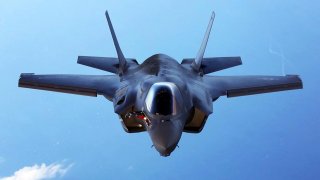How Turkey Plans to Get Its Hands on Its Own Stealth Fighter
Buy from abroad or make a new one at home?
Key point: Ankara is looking at Moscow or Beijing as potential sellers. Alternatively, Turkey could try to build its own stealth fighter although that would be much harder.
The United States in July 2019 kicked Turkey out of the multi-national effort to develop and build F-35 stealth fighters.
The Turkish government had insisted on buying Russian-made air-defense systems that U.S. officials claimed could gather sensitive data on the F-35, data that could make its way to Russia.
This first appeared in 2019 and is being reposted due to reader interest.
Ankara had planned to buy as many as 100 F-35s to equip its air force and potentially even fly from a new class of assault ships. Now Turkey is looking elsewhere for new fighters, all while rebuffing calls from former allies in the West to end its invasion of northern Syria.
“Offers are coming in,” embattled Turkish president Recep Tayyip Erdogan said, according to broadcaster NTV.
But those offers might not include a radar-evading plane in the class of the F-35. There are just two stealth fighters besides the F-35 that are in production and in theory even are available for export. The Russian Su-57 and the Chinese J-20.
But Chinese officials apparently are not keen to ship the J-20 beyond China’s borders, much in the same way U.S. lawmakers passed a law barring the export of the U.S. Air Force’s F-22.
In 2014, Song Zhongping, a former officer in Beijing’s strategic missile force, told a Chinese T.V. program that Beijing had banned any export of the J-20 “in order to keep J-20’s fifth-generation technology out of hostile hands.”
Chinese firm Shenyang is developing, as a purely commercial venture with little or no government support, the lightweight FC-31 stealth fighter as a potential export commodity. But progress has been slow. It’s unlikely that Shenyang is taking orders for the plane.
That leaves the Su-57, Russia’s own answer to the F-22. Russian president Vladimir Putin in August 2019 showed Erdogan around Russia’s MAKS air show. The two leaders inspected a Su-57. "So now, we are going to buy this one?" Erdogan asked Putin.
"You could," Putin replied.
But the Su-57 still is in development. It lacks key combat systems. Manufacturer Sukhoi hasn’t set up a big, efficient production line for the type. And Moscow almost certainly doesn’t have the money to buy a large number of the stealth fighters, meaning their per-unit price could be relatively high.
Putin in May 2019 claimed that Sukhoi had driven down the cost of a Su-57 by 20 percent, The Russian president announced that the Kremlin by 2027 would buy 76 Su-57s instead of just 16, as it previously had planned to do.
“I hope that the adjusted plans will be executed,” Putin said. But hope is not the same thing as a firm order. It’s unclear whether Sukhoi really is, or even can, build those 76 Su-57s for Russia, to say nothing of assembling additional Su-57s for Turkey.
The Russian Su-35, by contrast, has completed development. It’s already in production for several customers including Russia and China. Turkey and Russia in September 2019 reportedly began discussing a potential Turkish acquisition of Su-35s.
But the Su-35 is a conventional fighter and lacks stealth features. Buying new fighters right now means Turkey probably won’t be able to buy stealth fighters. It’s not for no reason that Ankara has launched development of a homegrown radar-evading fighter, the TF-X.
Of course, the TF-X faces its own huge obstacles. It costs around $100 billion in total to develop, build and operate a fleet of a few dozen stealth fighters, according to an assessment by Japanese air force general Hideyuki Yoshioka, who in 2011 helped to oversee Japan’s own boutique stealth-fighter program.
The F-35 consumes roughly $10 billion of the United States’ $700-billion-a-year defense budget. That’s around 1.5 percent. And just barely affordable. Turkey, by contrast, spends just $20 billion annually on its armed forces. Try squeezing a $100-billion stealth-fighter program into that budget.
All things considered, the Su-35 appears most likely to be Turkey’s next fighter. And it could be a long time before Turkey follows up the Su-35 with a radar-evading plane.
This first appeared in 2019 and is being reposted due to reader interest.
Image: Reuters

